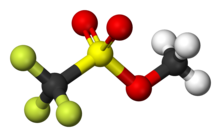
| |

| |
| Names | |
|---|---|
| Preferred IUPAC name
Methyl trifluoromethanesulfonate | |
| Other names
Trifluoromethanesulfonic acid, methyl ester
Triflic acid, methyl ester, methyl triflate | |
| Identifiers | |
3D model (JSmol)
|
|
| ChemSpider | |
| ECHA InfoCard | 100.005.793 |
| EC Number |
|
PubChem CID
|
|
| UNII | |
| UN number | 2924 |
CompTox Dashboard (EPA)
|
|
| |
| |
| Properties | |
| C2H3F3O3S | |
| Molar mass | 164.10 g·mol−1 |
| Appearance | Colourless Liquid |
| Density | 1.496 g/mL |
| Melting point | −64 °C (−83 °F; 209 K) |
| Boiling point | 100 °C (212 °F; 373 K) |
| Hydrolyzes | |
| Hazards[1] | |
| Occupational safety and health (OHS/OSH): | |
Main hazards
|
Corrosive |
| GHS labelling: | |
| Danger | |
| H226, H301, H311, H314, H330 | |
| P210, P233, P303+P361+P353, P304+P340+P310, P305+P351+P338, P380 | |
| Flash point | 38 °C (100 °F; 311 K) |
| Related compounds | |
Related compounds
|
Methyl fluorosulfonate |
Except where otherwise noted, data are given for materials in their standard state (at 25 °C [77 °F], 100 kPa).
| |
Methyl trifluoromethanesulfonate, also commonly called methyl triflate and abbreviated MeOTf, is the organic compound with the formula CF3SO2OCH3. It is a colourless liquid which finds use in organic chemistry as a powerful methylating agent.[2] The compound is closely related to methyl fluorosulfonate (FSO2OCH3). Although there has yet to be a reported human fatality, several cases were reported for methyl fluorosulfonate (LC50 (rat, 1 h) = 5 ppm), and methyl triflate is expected to have similar toxicity based on available evidence.[3][verification needed]
- ^ "Methyl trifluoromethanesulfonate". Sigma-Aldrich. Retrieved 31 October 2021.
- ^ Alder, Roger W.; Phillips, Justin G. E.; Huang Lijun; Huang Xuefei (2005). "Methyltrifluoromethanesulfonate". Encyclopedia of Reagents for Organic Synthesis. doi:10.1002/047084289X.rm266m.pub2. ISBN 0471936235.
- ^ Alder, R. W.; Sinnott, M. L.; Whiting, M. C.; Evans, D. A. (1978). "Hazards of powerful methylating agents". Chemistry in Britain. Vol. 14, no. 7. p. 324. Miscited as ——— (1976) Chem. Eng. News, vol. 54, no. 36, p. 56 in Alder et al. 2005